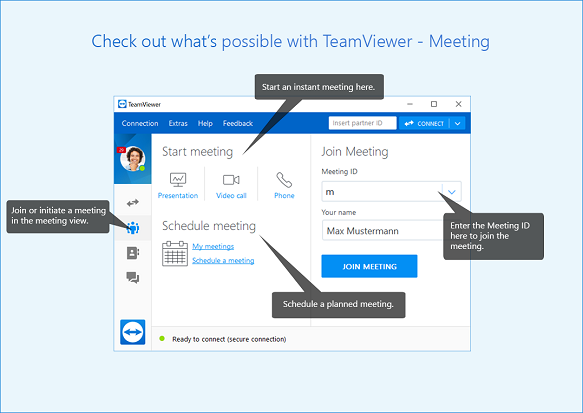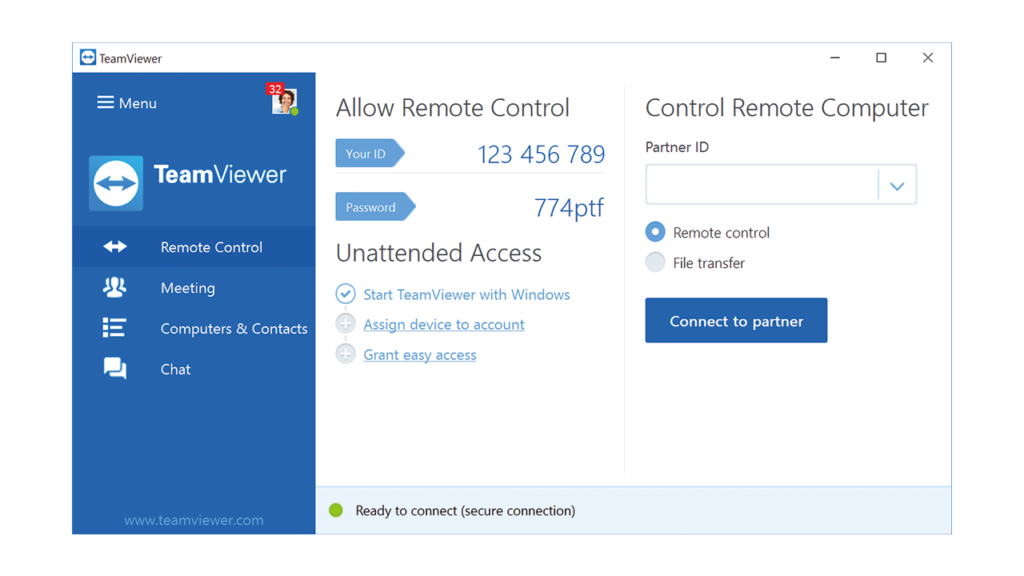DEAViewer
Remote control Windows, Mac, and Linux computers with TeamViewer: Remote Control within seconds. Provide spontaneous support for friends and family, or access applications on your home computer while on the go. The TeamViewer app allows you to accomplish all of this as if you were sitting right in front of the remote computer.

Sometimes it is crucial to help one of your friends, partners or colleagues to set up PC remotely, to perform some customization, to install an app or manage some other configuration options. The special software entitled TeamViewer will assist you with this task.
The principle of TeamViewer operations in Windows 10 OS is very simple: on the running of the app you may see your personal ID-number and a digital password. With its assistance another person may access this PC remotely and connect to it. For this you need to send your ID and password via Viber or Skype. If you need to gain control of remote PC, you have to know his ID and password appropriately. The ID-number of another computer is entered into the “Partner ID” field.
You can not only gain full remote control of distant PC, but also perform basic reboot and lock operations, leave text notes, send key combinations, invite additional participants to your web-conference (if you do this, you need to select the person you would like to invite from the contact list and in an instant he will receive a notification, which he will need to accept in 20 seconds). Also you may switch the view resolution and the screen size from full-screen to windowed mode according to your selection. In addition, you may customize the picture quality from speed optimization to quality optimization. If you select speed optimization, the picture will be less qualitative, but you will be able to perform all the operations remotely faster, than usual. If you choose quality optimization, the quality will be higher, but you will need to sacrifice the speed of operations accordingly.
One more important feature is the communication. You may arrange the text chat and video conference with the remote user and manage either internet or telephone calls with the users. If you want to use the screen as whiteboard in order to share some message to the person, you are freely capable to do that, writing a memo right on the screen for the distant user.
- Get support for your mobile device from any Windows or Mac computer! You can now receive technical remote support for your mobile devices. Technicians have the ability to chat, transfer files back and forth, view device information, stop processes, push and pull Wi-Fi settings, and much more. It is even possible for your device (Samsung, Sony., Asus, Lenovo, HTC, LG, ZTE, Huawei, Alcatel One.
- TeamViewer file transfer not working; TeamViewer mouse not working; TeamViewer wake on LAN (Local Area Network) not working; When you are one of the victims, you should read the following content carefully in order to find suitable methods for solving the TeamViewer problems. How to Fix TeamViewer Issues on Windows Computers.
Among the miscellaneous abilities are operations with files: remote printing activation, taking screenshot, start session recording, opening file transfer or sharing via file box (computer to computer, or involving the cloud service: Google Drive, OneDrive, Box or other).
Using TeamViewer is very comfortable and cozy: all the operations are absolutely intuitive, the speed of connecting to the remote PC is high and stable. One more thing, that definitely should be mentioned, is the capability for free usage of the application for non-commercial purposes. In this case you won’t notice any limitations or restrictions during the application of the software.
If you want to have a personal look on the capabilities and features of the product, just download TeamViewer for Windows 10 for free and enjoy the usage of the app according to your private preferences and predilections. You will learn all of its features for mere couple of seconds, and afterwards it will serve you well for many years.
Downloads TeamViewer for Windows 10?
Share the page on your site:

This tutorial describes the steps you need to perform in both TeamViewer and Azure Active Directory (Azure AD) to configure automatic user provisioning. When configured, Azure AD automatically provisions and de-provisions users and groups to TeamViewer using the Azure AD Provisioning service. For important details on what this service does, how it works, and frequently asked questions, see Automate user provisioning and deprovisioning to SaaS applications with Azure Active Directory.
Capabilities supported
- Create users in TeamViewer
- Remove users in TeamViewer when they do not require access anymore
- Keep user attributes synchronized between Azure AD and TeamViewer
- Single sign-on to TeamViewer (recommended)
Prerequisites

The scenario outlined in this tutorial assumes that you already have the following prerequisites:
- A user account in Azure AD with permission to configure provisioning (e.g. Application Administrator, Cloud Application administrator, Application Owner, or Global Administrator).
- A valid Tensor license for TeamViewer.
- A valid custom identifier from the Single Sign-On configuration available.
Step 1. Plan your provisioning deployment
- Learn about how the provisioning service works.
- Determine who will be in scope for provisioning.
- Determine what data to map between Azure AD and TeamViewer.
Step 2. Configure TeamViewer to support provisioning with Azure AD
Login to TeamViewer Management Console. Navigate to Edit Profile.
Navigate to Apps. Click on Create Script Token.
Provide a name for the script token. Click on the Save button.
Copy the Token and click OK. This value will be entered in the Secret Token field of your TeamViewer application in the Azure portal.
Step 3. Add TeamViewer from the Azure AD application gallery
Add TeamViewer from the Azure AD application gallery to start managing provisioning to TeamViewer. If you have previously setup TeamViewer for SSO you can use the same application. However it is recommended that you create a separate app when testing out the integration initially. Learn more about adding an application from the gallery here.

Step 4. Define who will be in scope for provisioning
The Azure AD provisioning service allows you to scope who will be provisioned based on assignment to the application and or based on attributes of the user / group. If you choose to scope who will be provisioned to your app based on assignment, you can use the following steps to assign users and groups to the application. If you choose to scope who will be provisioned based solely on attributes of the user or group, you can use a scoping filter as described here.
When assigning users and groups to TeamViewer, you must select a role other than Default Access. Users with the Default Access role are excluded from provisioning and will be marked as not effectively entitled in the provisioning logs. If the only role available on the application is the default access role, you can update the application manifest to add additional roles.
Start small. Test with a small set of users and groups before rolling out to everyone. When scope for provisioning is set to assigned users and groups, you can control this by assigning one or two users or groups to the app. When scope is set to all users and groups, you can specify an attribute based scoping filter.
Step 5. Configure automatic user provisioning to TeamViewer
This section guides you through the steps to configure the Azure AD provisioning service to create, update, and disable users and/or groups in TestApp based on user and/or group assignments in Azure AD.
To configure automatic user provisioning for TeamViewer in Azure AD:
Sign in to the Azure portal. Select Enterprise Applications, then select All applications.
In the applications list, select TeamViewer.
Select the Provisioning tab.
Set the Provisioning Mode to Automatic.
Under the Admin Credentials section, enter
ttps://webapi.teamviewer.com/scim/v2in the Tentant URL field and enter the script token created earlier in the Secret Token. Click Test Connection to ensure Azure AD can connect to TeamViewer. If the connection fails, ensure your TeamViewer account has Admin permissions and try again.In the Notification Email field, enter the email address of a person or group who should receive the provisioning error notifications and select the Send an email notification when a failure occurs check box.
Select Save.
Under the Mappings section, select Synchronize Azure Active Directory Users to TeamViewer.
Review the user attributes that are synchronized from Azure AD to TeamViewer in the Attribute-Mapping section. The attributes selected as Matching properties are used to match the user accounts in TeamViewer for update operations. If you choose to change the matching target attribute, you will need to ensure that the TeamViewer API supports filtering users based on that attribute. Select the Save button to commit any changes.
Attribute Type userName String displayName String active Boolean To configure scoping filters, refer to the following instructions provided in the Scoping filter tutorial.
To enable the Azure AD provisioning service for TeamViewer, change the Provisioning Status to On in the Settings section.
Define the users and/or groups that you would like to provision to TeamViewer by choosing the desired values in Scope in the Settings section.
When you are ready to provision, click Save.
This operation starts the initial synchronization cycle of all users and groups defined in Scope in the Settings section. The initial cycle takes longer to perform than subsequent cycles, which occur approximately every 40 minutes as long as the Azure AD provisioning service is running.
Step 6. Monitor your deployment
Once you've configured provisioning, use the following resources to monitor your deployment:
- Use the provisioning logs to determine which users have been provisioned successfully or unsuccessfully
- Check the progress bar to see the status of the provisioning cycle and how close it is to completion
- If the provisioning configuration seems to be in an unhealthy state, the application will go into quarantine. Learn more about quarantine states here.
Teamviewer Remote Support
Additional resources
Teamviewer.com Download Free
Next steps
